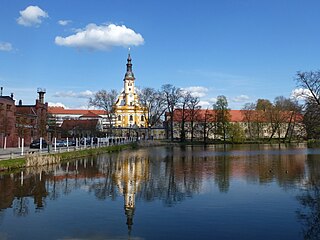
Neuzelle is a municipality in the Oder-Spree district of Brandenburg, Germany, the administrative seat of Amt Neuzelle. It is best known for Cistercian Neuzelle Abbey and its Neuzeller Kloster Brewery.
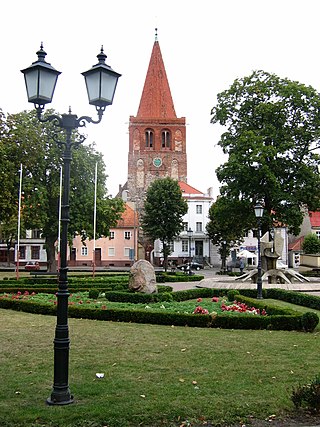
Myślibórz is a town in northwestern Poland, in West Pomeranian Voivodeship. It is the capital of the Powiat of Myślibórz, with a population of 11,867.

Waldemar the Great, a member of the House of Ascania, was Margrave of Brandenburg-Stendal from 1308 until his death. He became sole ruler of the Margraviate of Brandenburg upon the death of his cousin John V of Brandenburg-Salzwedel in 1317. Waldemar is known as the last in the line of Ascanian margraves starting with Albert the Bear in 1157; he was only succeeded by his minor cousin Henry II, who died one year later.

Kloster Lehnin, or just Lehnin, is a municipality in the German state of Brandenburg. It lies about 24 km (15 mi) west-south-west of Potsdam.

Altstadt Spandau is the historic centre of the Spandau borough in the western suburbs of Berlin, situated on the right bank of the Havel river by its confluence with the Spree tributary. It arose near the site of a former Slavic gord during the German eastward expansion (Ostsiedlung) in the early 13th century. A castle at Spandowe, erected on a Havel island to secure the eastern borderlands of the Margraviate of Brandenburg, was already documented in an 1197 deed issued by the Ascanian margrave Otto II.
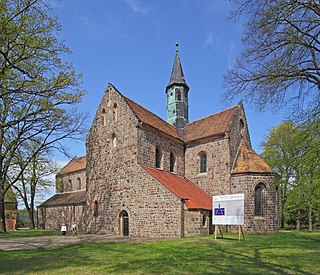
Zinna Abbey is a former Cistercian monastery, the site of which is now occupied by a village also called Kloster Zinna, today part of Jüterbog in Brandenburg, Germany, about 60 km (37 mi) south of Berlin. The village was established by Frederick II of Prussia as a village for weavers.

Sittichenbach Abbey, sometimes also known as Sichem Abbey, is a Cistercian monastery in Sittichenbach, now part of Osterhausen near Eisleben in the Mansfeld-Südharz district, Saxony-Anhalt, Germany.

The Margraviate of Brandenburg was a major principality of the Holy Roman Empire from 1157 to 1806 that, having electoral status although being quite poor, grew rapidly in importance after inheriting the Duchy of Prussia in 1618 and then came to play a pivotal role in the history of Germany and that of Central Europe as core of the Prussian kingdom.
Otto I was the second Margrave of Brandenburg, from 1170 until his death.
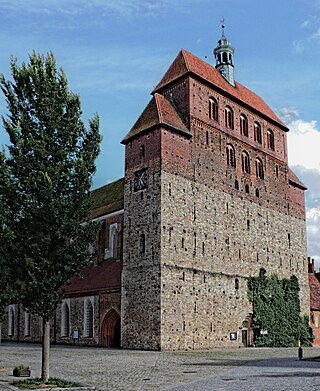
The Bishopric of Havelberg was a Roman Catholic diocese founded by King Otto I of Germany in 946, from 968 a suffragan to the Archbishops of Magedeburg. A Prince-bishopric (Hochstift) from 1151, Havelberg as a result of the Protestant Reformation was secularised and finally annexed by the margraves of Brandenburg in 1598.

Louise Henriette of Nassau was a Countess of Nassau, granddaughter of William I, Prince of Orange, "William the Silent", and an Electress of Brandenburg.

Spandau is a locality (Ortsteil) of Berlin, Germany's capital and largest city, in the homonymous borough (Bezirk) of Spandau. The historic city is situated, for the most part, on the western banks of the river Havel. As of 2020, the estimated population of Spandau was 39,653.

Hedwig, a member of the royal House of Habsburg, was Margravine of Brandenburg from 1279 until her death, by her marriage with the Ascanian margrave Otto VI of Brandenburg-Salzwedel.

John I, Margrave of Brandenburg was from 1220 until his death Margrave of Brandenburg, jointly with his brother Otto III "the Pious".

Otto III, nicknamed the pious was Margrave of Brandenburg jointly with his elder brother John I until John died in 1266. Otto III then ruled alone, until his death, the following year.
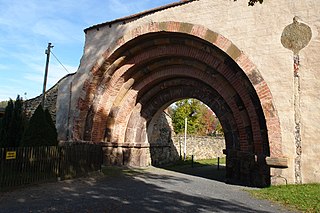
Altzella Abbey, also Altzelle Abbey, is a former Cistercian monastery near Nossen in Saxony, Germany. The former abbey contains the tombs of the Wettin margraves of Meissen from 1190 to 1381.
Albert III, Margrave of Brandenburg-Salzwedel was a Margrave of Brandenburg. He was a member of the Brandenburg-Salzwedel branch of the House of Ascania, which existed from 1266 to 1317. He was a son of Otto III and his wife, Beatrice of Bohemia.

John II, Margrave of Brandenburg-Stendal was co-ruler of Brandenburg with his brother Otto "with the arrow" from 1266 until his death. He also used the title Lord of Krossen, after a town in the Neumark.
Lehnin Training Area is a military training area in Potsdam-Mittelmark, in the state of Brandenburg, in Germany. It covers some 74 square kilometers.


















